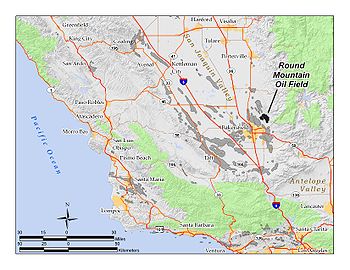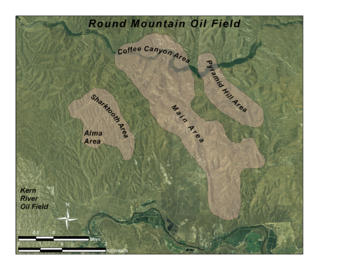
Round Mountain Oil Field
Encyclopedia

Bakersfield, California
Bakersfield is a city near the southern end of the San Joaquin Valley in Kern County, California. It is roughly equidistant between Fresno and Los Angeles, to the north and south respectively....
. It is east of the giant Kern River Oil Field
Kern River Oil Field
The Kern River Oil Field is a large oil field in Kern County in the San Joaquin Valley of California, north-northeast of Bakersfield in the lower Sierra foothills...
, one of the largest in the United States, and also close to the Mount Poso Oil Field
Mount Poso Oil Field
The Mount Poso Oil Field is a large oil and gas field in the lower foothills of the Sierra Nevada Mountains in Kern County, California. Discovered in 1926, and relatively close to exhaustion with less than three percent of its original oil remaining, it is the 21st largest field in California by...
and Kern Front Oil Field
Kern Front Oil Field
The Kern Front Oil Field is a large oil and gas field in the lower Sierra Nevada foothills in Kern County, California. Discovered in 1912, and with a cumulative production of around of oil, it ranks 29th in size in the state, and is believed to retain approximately ten percent of its original oil...
. With a cumulative total recovery of more than 110 million barrels of oil, it is the 48th largest oil field in California, but remains relatively productive with still about ten percent of its reserves remaining in the ground, according the California Department of Oil, Gas, and Geothermal Resources (DOGGR).
Setting

Kern River
The Kern River is a river in the U.S. state of California, approximately long. It drains an area of the southern Sierra Nevada mountains northeast of Bakersfield. Fed by snowmelt near Mount Whitney, the river passes through scenic canyons in the mountains and is a popular destination for...
and Poso Creek, in the lower foothills of the Sierra Nevada Mountains. The main access to the field is from the south, by way of Round Mountain Road, which also passes through the huge and much more densely developed Kern River Oil Field
Kern River Oil Field
The Kern River Oil Field is a large oil field in Kern County in the San Joaquin Valley of California, north-northeast of Bakersfield in the lower Sierra foothills...
. Elevations on the Round Mountain Field range from around 700 feet (213.4 m) at Poso Creek to 1612 feet (491.3 m) at Round Mountain itself. Topographic relief is high in some parts of the field, especially the northern part of the Main Area, which is intersected by numerous deep canyons.
Being mostly within the ecological subsection of the California Central Valley
California Central Valley
California's Central Valley is a large, flat valley that dominates the central portion of California. It is home to California's most productive agricultural efforts. The valley stretches approximately from northwest to southeast inland and parallel to the Pacific Ocean coast. Its northern half is...
known as the Hardpan Terraces, the predominant native vegetation is needlegrass
Needlegrass
The term needlegrass may refer to any of several genera of grasses, including:*Achnatherum*Aristida *Nassella*Stipa...
, with some scrub occurring, especially on north-facing slopes. The climate is hot and arid, with summertime temperatures routinely exceeding 100 °F (37.8 °C); the mean freeze-free period runs from about 250 to 300 days. Mean annual precipitation is around 10 inches (254 mm), almost all as rain and almost all in the winter; summers are generally rainless. Runoff is quick, and streams are dry in the summer and early autumn; water from the area flows out by Poso Creek and the Kern River to closed basins in the southern San Joaquin Valley, including Buena Vista Lake.
The field itself is spread out into five named areas, several of which consist of multiple discontiguous productive regions. The Main Area is the largest, consisting of one pool about five miles (8 km) long by half a mile across, extending north to south from Poso Creek to Kern River, and including Round Mountain. North of the main area is the Coffee Canyon Area, and northeast is the Pyramid Area. To the west of the Main Area are the two separate pools in the Sharktooth Area, and the two pools in the Alma Area. The total productive area of the entire field is 2630 acres (10.6 km²), or approximately four square miles.
Geology
Oil in the Round Mountain Field comes from four primary pools, the Freeman-Jewett, Pyramid Hill, Vedder, and Walker. Each resides in a sedimentary formation equivalently named, and are listed from top to bottom in stratigraphic sequence. The Freeman-Jewett and Pyramid Hill are of MioceneMiocene
The Miocene is a geological epoch of the Neogene Period and extends from about . The Miocene was named by Sir Charles Lyell. Its name comes from the Greek words and and means "less recent" because it has 18% fewer modern sea invertebrates than the Pliocene. The Miocene follows the Oligocene...
Age; the Vedder of Oligocene
Oligocene
The Oligocene is a geologic epoch of the Paleogene Period and extends from about 34 million to 23 million years before the present . As with other older geologic periods, the rock beds that define the period are well identified but the exact dates of the start and end of the period are slightly...
; and the lowest-lying productive unit, the Walker formation, was deposited during the Eocene
Eocene
The Eocene Epoch, lasting from about 56 to 34 million years ago , is a major division of the geologic timescale and the second epoch of the Paleogene Period in the Cenozoic Era. The Eocene spans the time from the end of the Palaeocene Epoch to the beginning of the Oligocene Epoch. The start of the...
and Oligocene. Of these units, the Vedder has been by far the most productive, with over 50 million barrels of oil being extracted.
The field is bounded on the northeast by a fault which serves as a structural trap since it is upgradient from the oil pools. Basement rocks underneath the productive units are of Jurassic age, and at around 4000 feet (1,219.2 m) are not particularly deep for a Kern County oil field. The deepest well on the field is the Killingsworth "Alma" No. 6, at 4418 feet (1,346.6 m), which reached the granitic basement.
Oil from the field generally heavy, with API gravity
API gravity
The American Petroleum Institute gravity, or API gravity, is a measure of how heavy or light a petroleum liquid is compared to water. If its API gravity is greater than 10, it is lighter and floats on water; if less than 10, it is heavier and sinks...
ranging from 13 at the Sharktooth and Alma areas to 22 in the Jewett pool in the Main Area. Waterflooding and cyclic steam processes have been used to retrieve some of the heavier petroleum since the early 1960s.
History, production, and operations
The discovery well was drilled by Getty Oil, now part of Chevron Corp., in May 1927, in the Pyramid Hill pool of the Main Area. Dates of discovery of other parts of the field were 1928 for the Coffee Canyon Area, 1937 for the Pyramid Area, 1943 for the Sharktooth Area, and most recently 1974 for the Alma Area. The peak production for the field as a whole was 1938, during which 5,453,194 barrels of oil were pumped out.As of 2008, Chevron retained no operating units in the field, and the current operators included Macpherson Oil Co., Coffee Petroleum, Pace Diversified Corp., and Arthur McAdams. None of the major oil companies had operations at Round Mountain.

